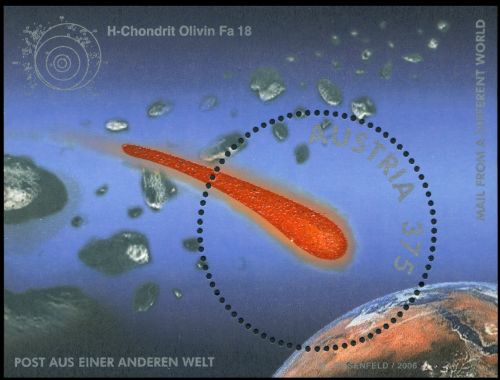United Nations 2023 "Don’t Choose Extinction"
| << previous | back to index | next >> |
| Issue Date | 20.06.2023 |
| ID |
Michel:, Scott: Austria - 711, Schwitzerland - 734, USA - 1320 Stanley Gibbons: , Yvert:, Category: Ot |
| Design | Rorie Katz, Activista creative agency and Framestore productions |
| Stamps in set | 3 |
| Values |
USD 1.45, CHF 2.30, EURO 1.90 Frankie the Dinosaur (Utahraptor) in the General Assembly Hall the United Nations in New York |
| Emission/Type | commemorative |
| Issue place | Vienna, Austria Geneva, Switzerland New York, USA |
| Size (width x height) | stamp size: 30.00mm x 40.00mm, Souvenir-Sheet: 110mm x 70mm |
| Layout | Souvenir-Sheets of 1 stamp |
| Products | FDC x3 |
| Paper | |
| Perforation | 14x13.25 |
| Print Technique | Offset, lithography |
| Printed by | Royal Joh Enschedé (The Netherlands) |
| Quantity | US$ 1.45 13,000 sheets; CHF 2,30 12,000 sheets; € 1,90 13,000 sheets |
| Issuing Authority | United Nations Postal Administration: USA, Switzerland, Austria |
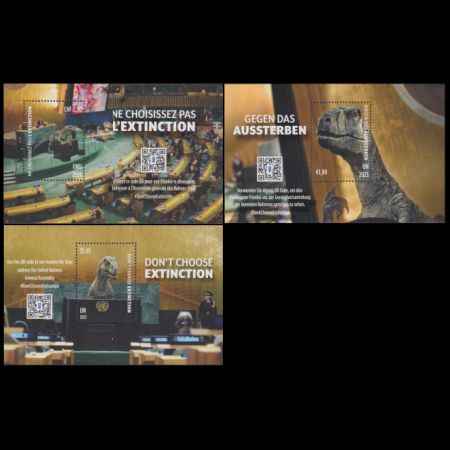
On June 20th, 2023, all three Postal Administrations (Vienna, Geneva, New York) of the United Nations issued Souvenir-Sheets "Don’t Choose Extinction". Each Souvenir-Sheet shows a different scene from a video created by the United Nations in 2021 to support the "Don't Choose Extinction" campaign.
The campaign which was launched by the United Nations Development Programme (UNDP) for the COP26 UN Climate Summit, calls for an end to fossil fuels and a global transition towards sustainable, green economies.
Each Souvenir-Sheet has a QR code that when scanned will launch the full video of Frankie Dinosaur addressing world leaders to take action against climate change. Boaz Paldi, UNDP Chief Creative Officer at UNDP said that the campaign hero appearing on UN stamps is an impressive step forward for the fight for global action around the climate crisis.
“We are very honored to have Frankie the Dino featured on official UN stamps. Beyond the recognition of the Don’t Choose Extinction campaign, this is an important reminder that all of us must take urgent climate action” Paldi said.
Bursting into the iconic United Nations General Assembly Hall, famous for history-making speeches by leaders from around the world, the imposing dinosaur tells an audience of shocked and bewildered diplomats and dignitaries that “it’s time humans stopped making excuses and started making changes” to address the climate crisis.
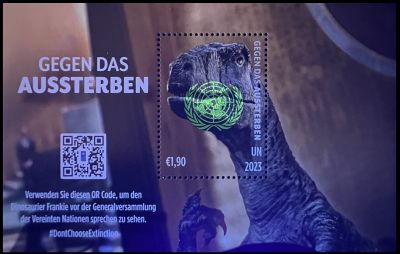 |
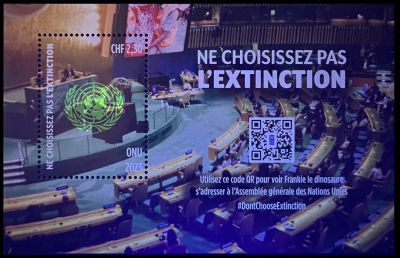 |
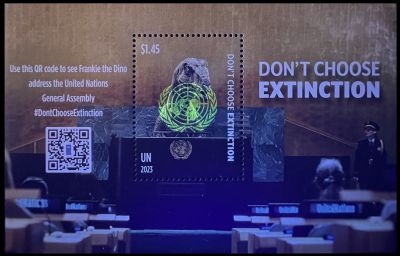 |
| "Don’t Choose Extinction" stamps of United Nations 2023, under UV light | ||
The “Don’t Choose Extinction” campaign was created in partnership with Activista, a purpose-driven creative agency based in Los Angeles (LA). Activista led the strategy and creation of the platform including the launch of the film, which was written in collaboration with David Litt, Barack Obama’s speech writer whilst in office. This first-ever film to be made inside the UN General Assembly using computer-generated imagery (CGI) features global celebrities voicing the dinosaur in numerous languages.
Activista also partnered with Framestore Pictures and Oscar-winning VFX studio Framestore to deliver the shoot and Computer-Generated (CG) dinosaur for the film.
The Framestore animation team headed by Marco Marenghi, one of the world’s leading dinosaur animators, developed the look and feel of the menacing creature, delicately striking a balance between anthropomorphism and realistic behavior.
The team worked closely together 20 years prior on the BBC Emmy Award-winning docuseries, Walking with Dinosaurs, Framestore Pictures director Murray Butler and Framestore creative director Marco Marenghi, were a perfect duo to bring the striking Utahraptor dinosaur to life.
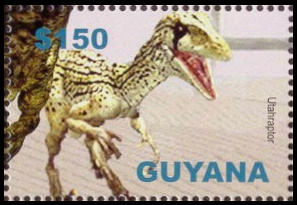
|
| Utahraptor dinosaur on stamp of Guyana 2005. The image is from 'Walking with Dinosaurs' BBC film. |
Utahraptor is a genus of large carnivorous (predator)
dinosaur, popularly called “raptor”, that lived during the Early Cretaceous period
(145-100 million years ago).
Utahraptor is found in the Yellow Cat Member at the base of the Cedar Mountain
Formation in outcrops around Arches National Park in east-central Utah.
Since 2018, Utahraptor has been Utah's State Dinosaur.
The largest species of Utahraptor, Utahraptor ostrommaysi is estimated
to have reached up to 7 meters long and somewhat less than 500 kg in weight,
comparable to a polar bear in weight.
The dinosaur had a large retractable sickle claw on its foot, specialized for cutting.
It was a ferocious hunter that used its sickle-shaped claws to attack and rip apart its prey.
Although feathers have never been found in association with Utahraptor specimens,
there is strong phylogenetic evidence suggesting that the dinosaur possessed them.
“We studied the way great speeches were delivered in film and TV and approached this project with the same cinematic language (just with a dinosaur as the orator),” said Butler. “We opted to use two cameras, which enabled us to covertly capture spontaneous reactions and cover action from a variety of levels and angles throughout the Hall. The stirring musical score, our CGI dinosaur hero, and the senior UN staff member and delegates who volunteered their time each brought this incredible film to life for an important cause.”
In the absence of soft tissue on a dinosaur’s “lips,” the team worked to achieve a believable lip sync that maintained a level of authenticity, opting for manufacturing phonemes by using jaw and tongue motion.
“We set about designing the dinosaur asset with unique skin that featured some iridescence, as we couldn't have feathers,” said Marenghi. “We wanted to retain some of the familiar raptor features, whilst feeling heavier and more imposing. It was important that the creature felt menacing, but not so much as to cause a panic stampede when it entered the Assembly Hall. It was a delicate balance to build the tension without terror.”
Jim Stewart, sound designer, add:
“It was a pleasure to be involved in the UNDP’s Climate and Inequality campaign. While it has its cinematic moments and an amusing rug-pull, the sincerity of the message remained paramount - a warning for humans from a dinosaur’s perspective. Whilst working on the Utahraptor’s voice over, we spent a lot of time drawing a fine balance between the message remaining human and the sound feeling realistic. For us it was fun not having to follow the cinematic cliché of a dinosaur introducing itself to the audience via a deafening guttural roar. Instead we created intimate throat gurgles and sharp nostril flares to portray the beast’s foreboding mood.”
The film, where Frankie the Dino calls out Governments for spending billions on fossil fuel subsidies, instantly became a cultural phenomenon and a rallying cry for climate action. The campaign film has been viewed by more than 2.2 billion people across the world to the date of the stamps' issue and gained more than 4,000 media mentions across the globe. The original short film was voiced in 39 languages and features famous actors from around the world.
Climate change refers to long-term shifts in temperatures and weather patterns, mainly caused by human activities, particularly the burning of fossil fuels. The consequences of climate change are far-reaching and include extreme weather, intense droughts, water scarcity, severe fires, rising sea levels, flooding, melting polar ice, catastrophic storms and declining biodiversity. UNDP research, released as part of the campaign, shows that the world spends $423 billion annually just to subsidize fossil fuels – nearly three times the annual amount needed to eradicate extreme global poverty.
During the speech the dinosaur says: " Going extinct is a bad thing. And driving yourselves extinct? In 70 million years, that is the most ridiculous thing I have ever heard.”" and ends his speech by declaring to the audience:
“It’s time for you humans to stop making excuses and start making changes. Don’t Choose Extinction!”.
Dinosaurs are a diverse group of reptiles of the clade Dinosauria.
They first appeared during the Triassic period, between 245 and 233.23 million years ago.
They became the dominant terrestrial vertebrates after the Triassic–Jurassic extinction
event 201.3 million years ago and their dominance continued throughout the Jurassic
and Cretaceous periods, during 165 million years.
All non-avian dinosaurs and most lineages of birds became extinct in a mass extinction event,
called the Cretaceous–Paleogene (K-Pg) extinction event.
The Cretaceous–Paleogene (K–Pg) extinction event, also known as the Cretaceous–Tertiary (K–T) extinction,
was a sudden mass extinction of three-quarters of the plant and animal species on Earth, approximately 66 million years ago.
It marked the end of the Cretaceous Period, and with it the Mesozoic era, while heralding the beginning of the Cenozoic era,
which continues to this day.
As originally proposed in 1980 by a team of scientists led by Luis Alvarez and his son Walter, it is now generally thought
that the K–Pg extinction was caused by the impact of a massive asteroid 10 to 15 km wide, 66 million years ago,
which devastated the global environment, mainly through a lingering impact winter which halted photosynthesis in plants
and plankton.
The impact hypothesis, also known as the Alvarez hypothesis, was bolstered by the discovery of the 180 km Chicxulub crater
in the Gulf of Mexico's Yucatán Peninsula in the early 1990s, which provided conclusive evidence that the K–Pg boundary clay
represented debris from an asteroid impact.
The fact that the extinctions occurred simultaneously provides strong evidence that they were caused by the asteroid.
| FDC | ||
| UN Postal Administration (Vienna) | UN Postal Administration (Geneva) | UN Postal Administration (New York City) |
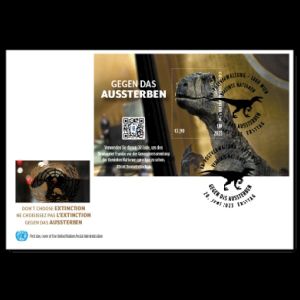 |
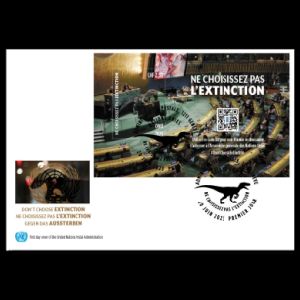 |
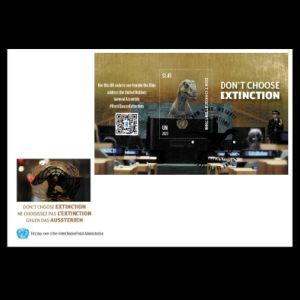 |
| First-Day-of-Issue Postmarks | ||
| UN Postal Administration (Vienna) | UN Postal Administration (Geneva) | UN Postal Administration (New York City) |
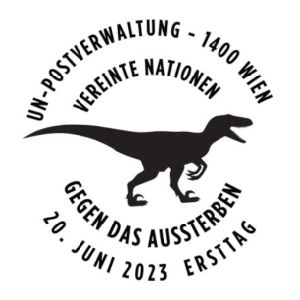 |
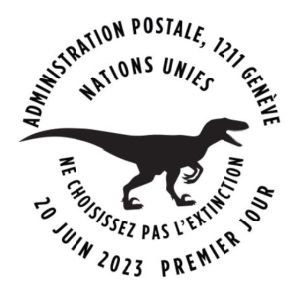 |
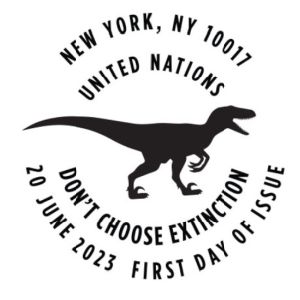 |
| Circulated FDC (UNPA Vienna) | Circulated FDC (UNPA Geneva) | Circulated FDC (UNPA New York) |
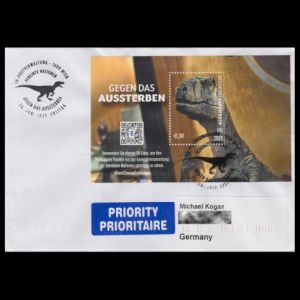 |
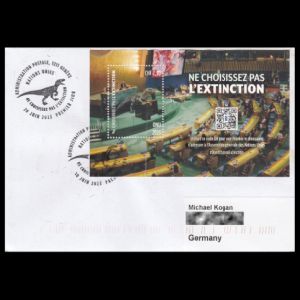 |
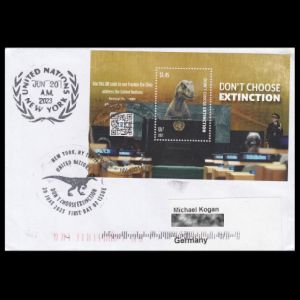 |
| Commemorative Cover | Referse side of official FDC | |
 |
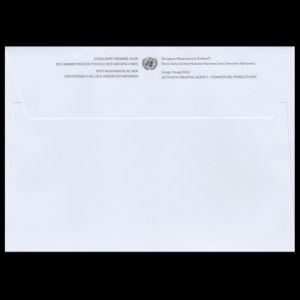 |
|
References
- Technical details and official press release: United Nations Postal Administration (UNPA) WOPA,
- "Don’t Choose Extinction": UNDP, devdiscourse
- Frankie the Dino: Framestore, LBB online,
- Utahraptor: Utah Paleo, Wikipedia
- Dinosaur extinction: Wikipedia
- Meteorite stamp of Austria: philateli.blogspot

|
Acknowledgements:
Many thanks to Dr. Peter Voice from Department of Geological and Environmental Sciences, Western Michigan University, for reviewing the draft page and his very valuable comments.
| << previous | back to index | next >> |
